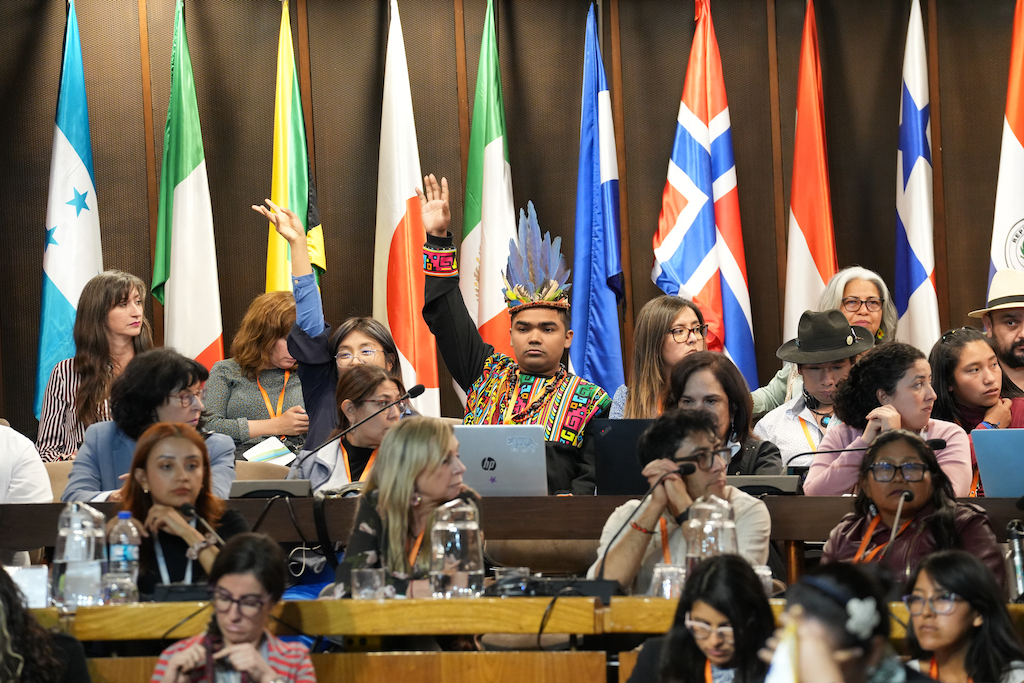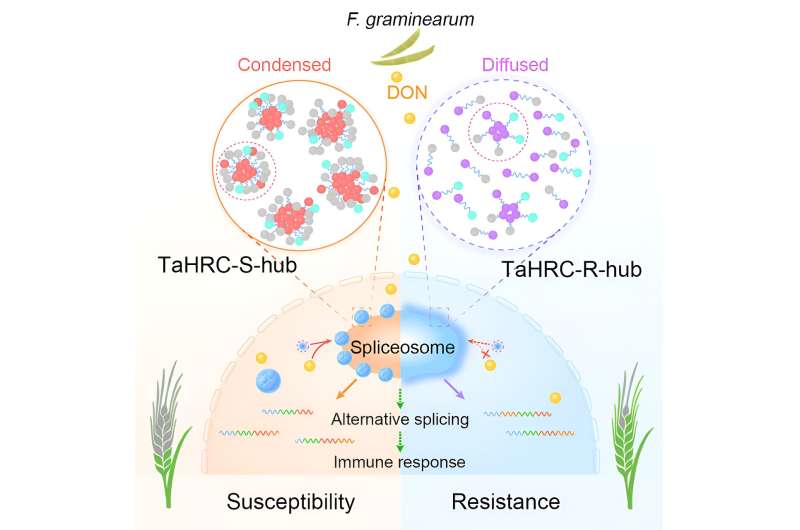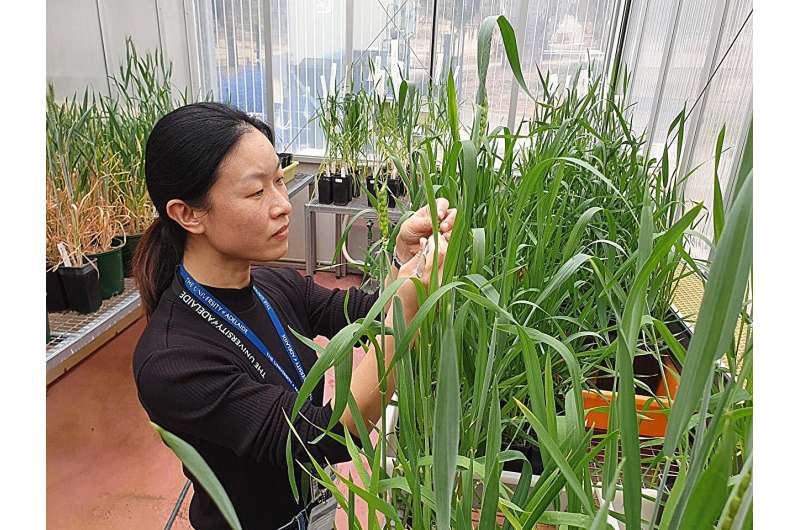This occurred at the third Conference of the Parties (COP3) to the Escazú Agreement, held in Santiago, Chile, from 22 to 24 April.
The Escazú Agreement, in force since 22 April 2021, is a legally binding regional treaty that aims to protect environmental defenders and promote public participation and access to information on environmental matters.
The conference brought together more than 700 people, from state parties and civil-society organisations to youth activists and Indigenous environmental defenders.
Latin America and the Caribbean is considered by campaign groups to be the “most dangerous place in the world for activists”.
The regional action plan sets out priority areas and strategic measures for countries to enact article 9 of the Escazú Agreement, which urges states to recognise and protect the rights of environmental defenders and prevent and punish attacks against them.
Graciela Martínez, regional campaigner for the Americas at Amnesty International, tells Carbon Brief that the action plan is an “important step towards implementing the Escazú Agreement”.
Action plan
Between 2012 and 2022, Latin America and the Caribbean saw 1,910 killings of environmental and land defenders, according to a 2023 report from campaign group Global Witness. This accounted for 88% of such killings around the world during that decade, the report notes.
The Escazú Agreement came out of the 2012 UN Conference on Sustainable Development and seeks to guarantee the right to a healthy environment and sustainable development for current and future generations. Part of this is achieved, the agreement says, by recognising the important role that environmental and human-rights defenders play in this regard.
Currently, 16 countries have ratified the Escazú Agreement, including Argentina, Bolivia, Chile, Mexico, Ecuador, and several Caribbean countries, such as Antigua and Barbuda, Grenada and Saint Kitts and Nevis. A recent statement by Amnesty International points out that some of the countries that have not yet ratified the agreement are among the most dangerous for environmental defenders, such as Brazil, Colombia and Guatemala.
The action plan agreed upon at COP3 will be implemented from 2024 to 2030 and comprises four priority areas, each accompanied by strategic measures to comply with objectives: Knowledge creation.
Recognition.
Capacity-building and cooperation for national implementation.
Evaluation of the action plan.
Knowledge creation refers to understanding the situation of defenders and identifying mechanisms to prevent and punish violations of defenders’ rights. Recognition measures require publicly acknowledging the work of defenders.
Within national implementation, the action plan mandates parties to create and strengthen institutions to provide free legal assistance to environmental defenders and training for judges and prosecutors.
 Objective of the priority area on capacity-building and cooperation for national implementation. Source: Action plan to protect environmental defenders.
Objective of the priority area on capacity-building and cooperation for national implementation. Source: Action plan to protect environmental defenders.Jesús Maya, a Mexican human-rights defender and youth representative at COP3, tells Carbon Brief:
“This is more than necessary for us to be able to talk about environmental justice and justice for people.”
Maya adds that the consultancy he manages, Eheco, is working to ensure that the Escazú processes “takes into account alternative justice” such as “collective justice” – as violence can also be directed at entire groups, not just individuals – and policies to preserve the “collective memory” of killed defenders, “so as not to repeat the issue”.
There are other examples of alternative justice, Maya says. One is Colombia’s special jurisdiction for peace – which seeks to deliver transitional justice to victims of the decades-long armed conflict by providing the right to justice, truth and restoration of damages. Another comes in the form of the truth commissions in Argentina, Peru, Chile, Mexico and Colombia, which were created to uncover the truth about human rights violations committed by military dictatorships, authoritarian regimes or internal armed conflicts.
Indigenous demands
Teresita Antazú López, an Indigenous environmental defender of the Yanesha people of the central Peruvian rainforest, tells Carbon Brief that Indigenous peoples had a number of demands at this COP.
According to López, who attended the COP3 as a member of the Interethnic Association for the Development of the Peruvian Jungle, the highest priority was to ensure their effective participation in the negotiations going forward. This includes having an Indigenous caucus to represent them and an Indigenous peoples rapporteur to report on violations in their territories.
 Indigenous and young representatives in the Escazú negotiations at COP3. Credit: ECLAC / Flickr
Indigenous and young representatives in the Escazú negotiations at COP3. Credit: ECLAC / FlickrAlice Piva, a Brazilian climate activist and young ambassador of the Escazú Agreement, tells Carbon Brief that young activists and defenders are asking for the recognition of their leadership and participation in the Escazú processes. She explains that environmental justice includes intergenerational justice, adding:
“It is up to the younger generations to push [the Escazú Agreement] forward to achieve this vision of a Latin America with a strong environmental democracy.”
Piva also criticises accessibility of the COP for Brazilian organisations, noting that negotiations are often held in Spanish and English and less frequently in Portuguese.
Information access
COP3 also addressed transparency and access to environmental information.
During a side event organised by Article 19 Mexico and Central America – an organisation that promotes freedom of expression and access to information, Maribel Ek, guardian of the cenotes – or deep natural wells – of Homún, in the south-eastern Mexican state of Yucatán, told the audience that her community, which is home to 360 cenotes, managed to shut down a 49,000-pig mega-farm on its territory after investigating the farm’s permits and receiving support from lawyers. Ek said:
“To defend nature, we just need information. We need to know the steps to follow, the places to touch and how to do it.”
Article 6 of the Escazú Agreement states that “each party shall ensure the right of public access to environmental information in its possession, control or custody, in accordance with the principle of maximum disclosure”.
However, during the event, speakers said the Latin America and the Caribbean region still has shortcomings when it comes to disclosure. For example, panellists pointed out, Peru lacks training for officials and the budget for disclosures.
Speaking at the side event, Lourdes Medina, a lawyer specialising in environmental and Indigenous rights, said that if the right to access environmental information is not protected and guaranteed, other rights are at risk. Medina said:
“Citizens’ participation in resistance cannot be guaranteed. There is no adequate mechanism for access to justice, and this produces different forms of violence against defenders.”
Current implementation
During COP3, seven countries presented their national plans – either approved or in progress – to implement the Escazú Agreement. According to the UN Economic Commission for Latin America and the Caribbean (ECLAC), Ecuador, Argentina, Santa Lucía, Belize, Mexico, Uruguay and Chile all presented their plans at the summit. The COP also welcomed Dominica as the 16th party to the agreement.
Maya tells Carbon Brief that Mexico’s plan for implementing the Escazú Agreement is on hold due to the country’s upcoming national elections.
Piva says she is working with civil society organisations to get Brazil to ratify the agreement. She said that given Brazil’s size and its leadership in economic issues and regional networks such as Mercosur, the Escazú Agreement also needs Brazil. She tells Carbon Brief:
“If Brazil does not ratify or takes too long to ratify, the agreement will lose strength because it needs the country as a strong negotiator.”
According to the Coordinator of Indigenous Organizations of the Amazon River Basin (COICA), this COP succeeded regarding the inclusion of public participation, including Indigenous peoples, in implementing national plans.
Defenders and civil society organisations consulted by Carbon Brief highlight the need for the COPs on Escazú to be annual rather than biannual since protecting defenders is an urgent matter. Piva says:
“I don’t think it’s fair that defenders already threatened or at risk [wait] more than two years to have [a tool] to demand that their countries protect them.”













 Senegalese sailors regard Chinese crew on a fishing vessel in Dakar in 2016. Image © Liu Yuyang / Greenpeace.
Senegalese sailors regard Chinese crew on a fishing vessel in Dakar in 2016. Image © Liu Yuyang / Greenpeace.
 A local fisher cleans his net near Bangonon Island, central Philippines. Image by Keith Anthony Fabro for Mongabay.
A local fisher cleans his net near Bangonon Island, central Philippines. Image by Keith Anthony Fabro for Mongabay.